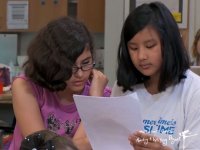Modeling Close Reading for Future Teachers: Why Video Works
For preservice teachers (PTs) to be able to teach well, they need to "get it" -- that aha! moment when they truly understand what good teaching looks like. My PTs often do not witness close reading (identified in the Common Core State Standards as a critical skill) modeled in their practicum. Fortunately, free high-quality video of this skill being taught can be found on the Internet and is among the most effective teaching tools I use.
My Background
For the past 30 years, I have taught reading and literacy methods in several Midwest and Rocky Mountain states where teacher candidates come from all walks of life -- from traditional undergraduates, to mothers returning to the work world after raising children, to older adults changing careers. They hail from different geographic regions and bring with them varied educational histories. Many, like myself, are first-generation college students.
The Challenge
The biggest single challenge for all these preservice teachers is to deeply understand what good literacy instruction looks like. Deep understanding cannot be acquired from taking notes on lectures, participating in cooperative learning activities, or studying articles and textbook chapters. And it is only through profound understanding of rich literacy instruction that PTs can generate exemplary lessons themselves.
Preservice teachers need to see good teaching with students and watch students' reactions. They need to hear what students say and observe how learners process the information presented. Video documentation of classrooms brings that experience to my preservice teachers. With this tool, I can tell PTs what to look for and stop the video at any point to discuss the instructor's choices. I can go back to revisit students' responses and how teachers negotiate those responses.
Mastering a Critical Practice with ELA Lessons on Video
To help my PTs understand how to do a close read, I walk them through the following steps:
- I model how to close read an article or text written for adults. I particularly like the essays of Christopher Hitchens for this activity since they are complex. Giving my PTs challenging texts enables them to feel and understand what their students will experience when facing a difficult text.
- In groups of four, PTs answer questions about and discuss three articles on close reading.
- Before I show a video of sixth graders learning how to close read, I direct my PTs to pay attention to what the teacher says at each stage of the lesson: annotating a text, independent work, reading, small-group work, etc. While attending to the video, PTs get a chance to see how the sixth grade instructor recognizes that her students don't fully understand the main idea of a selected text and asks them to reread the passage.
- The PTs gather in groups of four to identify specific steps that the instructor in the video employed to teach close reading. Using a T-chart, students record what the teacher said in the left column and why in the right. Following this activity, we discuss their T-chart notes to determine what the teacher said and did, and why.
- Next, PTs watch a video of a fourth grade teacher conducting a close read. The difficulty of the assigned texts necessitates that the teacher lead a whole-class discussion. Through posing excellent questions, the teacher expertly teases out important information about the text that eventually helps her students develop a compare/contrast essay about the two assigned passages.
- The PTs complete another T-chart in small groups on what the teacher said and did, and why, followed by a whole-group discussion of the video.
- At the end of this multistep activity, we summarize what we learned about close reading.
Real Teachers and Real Students
My PTs consistently tell me that watching these high-quality videos helps them understand close reading instruction at level that could not be attained through reading and discussion alone. While modeling close reading in a college class is somewhat helpful, PTs need to see one executed in a real classroom with real students. Because they rarely get a chance to see a close read in their school-site classrooms, videos are a critical feature of my methods courses.
Have you discovered any high-quality videos modeling classroom instruction? How do you use them? Please share links and comments below.
This is the first of three parts. In part two, I'll share my curated collection of ELA videos and webinars. Part three will feature what I've found to be exceptional professional websites for reading teachers.
